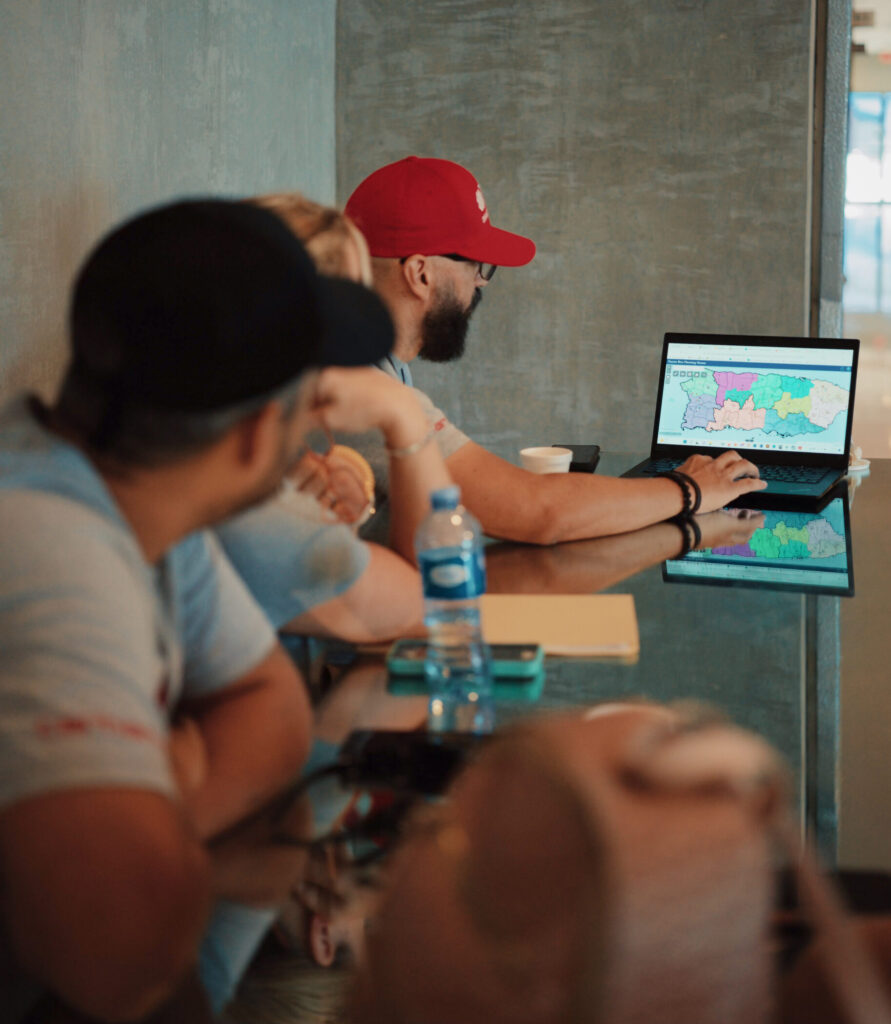Team Rubicon is a veteran-led humanitarian organization that serves global communities before, during, and after disasters. Founded by a handful of military veterans in response to the Haiti earthquake in 2010, our mission is fueled by the dedication and hard work of what is now 170,000 volunteers, or Greyshirts as we call them.
As a nonprofit working with the same limited resources as ever, yet faced with ever-increasing billion-dollar disasters, we face significant challenges: We must get as many Greyshirts into the field and doing disaster relief work as quickly and efficiently as possible after a disaster, without spending resources like a for-profit to do so. We must also keep our volunteers engaged between disasters—the privilege of having free time, and the liberty to use PTO not for leisure but to serve people on their worst days is significant, after all. And we need to work as efficiently as possible while on the ground, serving as many people as possible while minimizing drain on resources.
To solve for those things, Team Rubicon realized that we must scale impact, while simultaneously ensuring the best volunteering experience. For our organization, designing a digital transformation strategy where technology would serve as an enabler—though not the driver—would help us achieve all of this.
The Early Days, Where Everyone Did Everything
In its infancy, Team Rubicon operated in a highly flexible and dynamic environment. Resources were limited and the urgency of the mission—assisting survivors of the Moore tornadoes, Hurricane Sandy, and Hurricane Harvey, for example—required an all-hands-on-deck approach. Communication channels were informal, and decision-making was decentralized, reflecting the startup nature of Team Rubicon. Volunteers and staff wore multiple hats, tackling various roles and responsibilities as needed. There’s a saying in Team Rubicon that continues today: Everyone has a role, know it. In a disaster zone, even the CEO or four-star General turned Greyshirt might be tasked with swamping hurricane debris.
This lack of specialization fostered a culture of camaraderie and adaptability, essential for rapid response in crisis situations, however, it also meant that systems and processes were built in ad-hoc. Lack of clear functional boundaries allowed for swift action, but also often led to inefficiencies and redundancies.
As Team Rubicon grew, we gained the ability to establish more defined roles and departments. Functional groups emerged, each optimizing for their specific areas of operation. For instance, an operations team emerged to identify disasters with unmet needs and streamline disaster response processes, and a finance team was created that focused on enhancing budget management and reporting as well as ensuring funding for supplies was available in disaster zones.
While this specialization led to significant improvements within individual departments, it also introduced organizational friction. Systems were built in silos, each reflecting the communication and workflow preferences of their respective departments, a phenomenon described by Conway’s Law. This lack of integration resulted in fractured systems, where the smooth flow of information and coordination across the organization was hindered. For example, reconciling funding to budget to impact became much more time-consuming due to these siloed systems.
Team Rubicon also began to outgrow the basic technology that allowed us to respond quickly. Managing our Greyshirts—their addresses, home airports for deployments, all of their training and skills, as well as the operations they had deployed on–and getting them deployed via a spreadsheet became untenable when we reached around 50,000 volunteers.
The math was simple: we could continue to do business as usual–siloed and with a spreadsheet—or we could transform our processes and adapt.
A Digital Transformation Strategy Built on Reforming Business Processes Begins
Recognizing the need to mature as an organization, in 2018 Team Rubicon embarked on a significant transformation journey, in partnership with Microsoft and consulting and accounting firm Wipfli.
Our digital transformation strategy was not just about adopting new technologies like M365 and Microsoft Dynamics, but fundamentally about transforming business processes. Transforming business processes is essential to overcoming organizational friction and achieving our goals. The focus should be on redesigning workflows, improving communication, and optimizing processes before implementing technological solutions. This ensures that technology investments are aligned with the organization’s strategic goals and operational needs.

For complex nonprofits such as ours—one that serves real people in chaotic situations and relies on the skills and talents of volunteers to do so—successful technology transformations also have to be a natural progression. You can’t have a complicated all-in-one system when you don’t know how you’re going to operate to begin with. We couldn’t, for example, have known that we needed a complex enterprise management system to manage all of our Greyshirts and their volunteer work had we not first done so in a spreadsheet and also more than tripled in size. These natural progressions are the moments when the good friction and the bad friction clash, and the negative friction begins to overshadow what success the good friction can create. That is when we see the sign that it’s time to go to that next level.
With these things in mind, we began implementing a digital transformation strategy that would move us from a heterogeneous set of SaaS applications to a more cohesive and integrated system. This digital transformation allowed Team Rubicon to realize efficiencies exponentially, enhancing the way both employees and volunteers operate. The focus was on streamlining workflows, improving communication, and creating a more unified organizational structure. By prioritizing business process transformations first, Team Rubicon ensured that technology investments were effectively supporting their strategic goals. This alignment of technology with communication structures also reflects the principles of Conway’s Law, where integrated systems design promotes seamless collaboration.
Scaling and the Flywheel Effect
Of the roughly 1.8 million nonprofits in the U.S., the vast majority generate less than $50 million a year and struggle with issues similar to those Team Rubicon faced in its early days. When Team Rubicon was smaller, our approach was necessarily flexible and adaptive. However, as we have grown, we have entered a new echelon of organizations. This growth means we must rethink and reframe our approach to maintain efficiency and maximize impact.
To advance now to the next level of organizational maturity, we must continue to shift our focus from purely functional optimization to a more holistic approach centered around specific outcomes and workflows. By incorporating the flywheel concept, popularized by Jim Collins in his book Good to Great, we can build momentum through consistent, small efforts that collectively drive significant impact. The flywheel effect describes how small, incremental steps can create unstoppable momentum over time, much like pushing a heavy flywheel that gradually builds speed.
Components of the Organizational Maturity Flywheel
- Outcome-Oriented Workflows: Define workflows that align with desired outcomes rather than departmental preferences. This means focusing on the end-to-end process of translating donor dollars into impact, ensuring each step is optimized for overall efficiency in order to serve more communities and be the best place to volunteer. By streamlining these workflows, we can maximize the impact of our resources, thereby driving the flywheel forward.
- Enhanced Communication Channels: Establish clear and consistent communication channels that bridge departmental gaps. Effective communication fosters collaboration and helps maintain the flywheel’s momentum by ensuring everyone is aligned and informed. Regular inter-departmental meetings, collaborative platforms, and shared goals can help align efforts and reduce friction.
- Continuous Improvement: Embrace a culture of continuous improvement. By continuously seeking ways to improve, we keep our flywheel spinning faster. Systematic feedback loops and incorporating lessons learned ensure that we adapt and improve continuously. This foundational mindset allows us to evolve in response to changing needs, further enhancing our effectiveness.
- Focused Prioritization: In a resource-constrained environment, maintain a clear focus on priority areas to drive outcomes faster. Prioritizing critical projects and aligning resources efficiently ensures that our efforts are concentrated where they can have the most impact, accelerating the flywheel. This focus helps avoid the dispersion of efforts and ensures that every action contributes meaningfully to the organization’s mission and goals.
Connecting the Dots for a Bold New Disaster Relief World
Utilizing the flywheel concept, our digital transformation is continuous. And, it is already proving out. Managing our more than 170,000 volunteers is no longer burdensome. Finance, fundraising, volunteer management, and Field Services—our tool for identifying homes in need of repair, defining the needed repair, and documenting what we did for each and every individual home—and more all live and function in one ecosystem.
With all of our disparate data in one common data model—from budgets and financing to roofs and hurricane survivors to disaster responders and the tarps they need to use to help people recover—we can connect the dots. As we increased the efficiency of our operations, we also streamlined our amplify the impact.
None of this is one-and-done: At Team Rubicon, we’re constantly iterating, innovating, and refining our processes and procedures. In doing so, we are able to rid ourselves of what almost works and capitalize on best practices that make us faster, better, and more efficient. By making the technology our volunteers use to serve survivors easier and more intuitive, we enable them to concentrate on meaningful work and maximize their impact.
As we continue to grow and mature, embracing the principles of business process transformation and effectively managing both good and bad organizational friction will be essential. By focusing on outcome-oriented workflows, enhanced communication channels, continuous improvement, and focused prioritization, we will improve internal operations and enhance our ability to respond swiftly and effectively to crises, staying true to our mission of serving those in need. This digital transformation strategy and flywheel effect, with its reinforcing cycle of improvement, satisfaction, and impact, will propel us toward our north star, ensuring that we maximize every donor dollar to serve more communities and become the best place to volunteer.

Sheng-te Yang
Sheng-te Yang serves as Team Rubicon’s Vice President of Data and Technology, responsible for steering the nonprofit’s strategic vision for tech, and then deploying the appropriate tools and people to make it happen.



